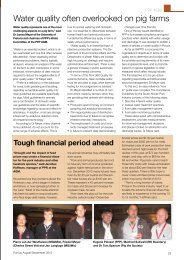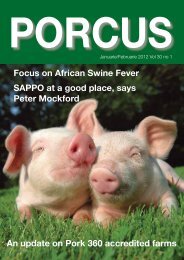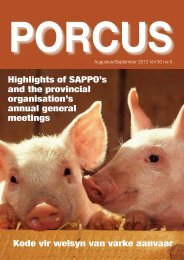• Quality assurance scheme to be rolled out nationally - sappo
• Quality assurance scheme to be rolled out nationally - sappo
• Quality assurance scheme to be rolled out nationally - sappo
You also want an ePaper? Increase the reach of your titles
YUMPU automatically turns print PDFs into web optimized ePapers that Google loves.
Smaller producers<br />
don’t always take<br />
biosecurity seriously<br />
enough<br />
Mike Benson, Hogan Stud<br />
1. What is your policy on biosecurity<br />
and do you think that local producers<br />
take biosecurity seriously<br />
enough?<br />
A good definition of biosecurity would<br />
<strong>be</strong> “measures imposed <strong>to</strong> protect a biological<br />
system from attack by potentially<br />
harmful microorganisms that can reduce<br />
the level of health of man and animals.”<br />
Many r<strong>out</strong>es exist for disease <strong>to</strong> gain<br />
entry <strong>to</strong> the farm. These include animate<br />
objects such as live pigs, dead pigs,<br />
people, birds, rodents, flies, and semen<br />
and inanimate objects such as transport,<br />
feed, air, water, clothing, <strong>to</strong>ols and<br />
equipment, food and drink items.<br />
Hogan is a closed herd, meaning that<br />
our new genetics are from semen, both<br />
fresh and frozen. We keep a strict fly<br />
control program using larval inhibi<strong>to</strong>rs.<br />
The lorry picking up pigs for slaughter is<br />
washed and disinfected <strong>be</strong>fore visiting<br />
the herd. A precaution against contamination<br />
from such lorries is having a safe<br />
pig-loading bay and by not allowing the<br />
driver in<strong>to</strong> the pig buildings. Visi<strong>to</strong>rs are<br />
reduced <strong>to</strong> a minimum and any that have<br />
<strong>to</strong> enter the piggery change in<strong>to</strong> clothes<br />
and boots that are kept on the farm. We<br />
also insist that visi<strong>to</strong>rs stay away from<br />
other pigs for a period of time <strong>be</strong>fore<br />
visiting us. Our staff keep away from wild<br />
pigs and other piggeries and wear clean<br />
clothing and boots <strong>to</strong> work each day. A<br />
secure, electrified perimeter fence keeps<br />
unwanted people and possible vec<strong>to</strong>rs<br />
<strong>out</strong>. Foot baths are provided at the<br />
entrance <strong>to</strong> the farm and at each building.<br />
We do not claim <strong>to</strong> <strong>be</strong> a high health<br />
herd but rather a high immune herd.<br />
This allows us <strong>to</strong> sell <strong>to</strong> smaller emerging<br />
farmers who require a more robust, less<br />
temperamental animal.<br />
Our feeling is that the smaller local<br />
producers don’t take biosecurity seriously.<br />
All pigs brought on<strong>to</strong> the farm<br />
should <strong>be</strong> quarantined, or at least physically<br />
separated from your own pigs for at<br />
least a month and treated with antibiotics<br />
at therapeutic levels for pneumonias,<br />
dewormed, demanged and vaccinated.<br />
At Hogan we feel that<br />
we have an underrated<br />
product that we don’t<br />
actively market, we<br />
also don’t feel that we<br />
want <strong>to</strong> tie people in<strong>to</strong><br />
a contract.<br />
A single source of breeding s<strong>to</strong>ck should<br />
also <strong>be</strong> used rather than buying from<br />
numerous sources and therefore from<br />
different disease profiles.<br />
2. What does the future hold for the<br />
pig breeding industry and on what<br />
breeding characteristics are you going<br />
<strong>to</strong> focus in the next decade and<br />
why?<br />
There is currently a huge amount of<br />
competition for market share with long<br />
term contracts for replacement s<strong>to</strong>ck<br />
<strong>be</strong>ing offered. At Hogan we feel that<br />
we have an underrated product that<br />
we don’t actively market, we also don’t<br />
feel that we want <strong>to</strong> tie people in<strong>to</strong> a<br />
contract. If someone is happy with what<br />
we provide they will come back for more.<br />
Our breeding goals for the next decade<br />
are not back fat or num<strong>be</strong>rs born alive<br />
which are at a very competitive level thus<br />
our concentration going forward will <strong>be</strong><br />
focused on feet, legs and sow longevity.<br />
Models have shown that production<br />
BReediNg<br />
Mike Benson, Hogan Stud<br />
systems with the lowest replacement<br />
rates were most profitable. Similarly,<br />
sows with high lifetime production values,<br />
a trait closely related <strong>to</strong> longevity,<br />
reduced breeding cost/pig weaned. A<br />
higher proportion of high-parity females<br />
is a clear indication of a herd’s lifetime<br />
reproductive performance. At Hogan we<br />
feel that the optimal economic time <strong>to</strong><br />
cull a sow is after her eighth or ninth parity.<br />
The bot<strong>to</strong>m line is that a replacement<br />
female must produce a sufficient num<strong>be</strong>r<br />
of offspring <strong>to</strong> offset her purchase price<br />
and maintenance costs. This edge can<br />
make one farm more successful than<br />
another. Reproductive failure, which can<br />
encompass a variety of problems such<br />
as failure <strong>to</strong> cycle or inability <strong>to</strong> conceive,<br />
is clearly the single biggest reason sows<br />
are removed from the breeding herd. Our<br />
grading figures are over 85% P’s and O’s<br />
on 73kg carcasses averaged over the<br />
last 12 months. Breeding thinner animals<br />
would only compromise sow condition<br />
at weaning. Thin sows at weaning have<br />
<strong>be</strong>en problematic ever since intensive<br />
management of the sow herd <strong>be</strong>came<br />
commonplace. Poor body condition<br />
contributes <strong>to</strong> poor reproductive performance.<br />
Once sows reach the fourth<br />
parity, culling for reproductive failure<br />
<strong>be</strong>comes less of an issue. Feet and leg<br />
structure is critical <strong>to</strong> ensure animals<br />
survive the desired nine lactations. As<br />
sows get older and heavier their litters<br />
also <strong>be</strong>come larger putting excessive<br />
strain on feet and legs, often resulting<br />
in collapse and therefore the inability <strong>to</strong><br />
rear their litter. Inter<strong>nationally</strong> there is<br />
talk of “30 pigs per sow per year” and<br />
the “two <strong>to</strong>n sow”, the only way this can<br />
<strong>be</strong> achieved is with sows that last parity<br />
after parity and we are confident that our<br />
genetics are up there with the <strong>be</strong>st.<br />
Porcus Novem<strong>be</strong>r/Decem<strong>be</strong>r 2010 25







